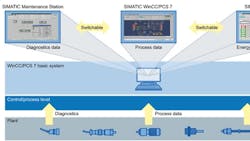Analyzing motion system efficiency with software
If only it were as simple as choosing an energy-efficient motor. The truth is that many components must work together for motion design efficiency. Software analysis can help pinpoint needed improvements.
Efficiency in the balance
Both component manufacturers and companies operating industrial plants can boost efficiency for competitive advantage. However, industrial-plant and system efficiencies depend on the application, so must be individually assessed. All relevant energy sources — electric power, gas, water, and compressed air — must be taken into account.
Where to start? It makes the most sense to begin by optimizing drive systems, as they represent the majority of power costs. Here, energy management software can monitor coordinated components and acquire detailed energy-usage data to help engineers formulate energy-saving followup plans.
Visualizing energy-saving potential
The basic prerequisite is to acquire all relevant data; in many cases, this can be done using technology already in place. Automation products such as circuit breakers and frequency converters automatically track current and voltage.
Additional data can be acquired via dedicated energy-measuring devices, often integrated into industrial communication networks such as Profibus or Profinet. Linked to the electrical network, they precisely measure voltage, current, and frequency, and then pass the information to the automation network and HMIs like any other process data.
Enter the energy-management software: By making collected information transparent, it allows engineers to identify machines that use a lot of energy. Usage data is displayed in operating and visualization interfaces and saved in long-term archives. Automatic allocation to cost centers allows identification of hidden energy-saving potential by comparing usage profiles and associated costs. Energy flows can also be evaluated: The software’s analysis makes it clear where changing process behaviors or components to other methods or designs can reduce energy costs.
Using component data to precisely estimate energy demand allows contractual-side reductions in total purchased energy.
When it comes to frequency converters, closed-loop speed control and energy recovery are invaluable for boosting efficiency. In contrast with mechanical control systems with closed-loop speed control, power drawn in partial-load operation is continually adapted to the actual demand — so no energy is wasted, slashing consumption by up to 70%. Converters featuring energy recovery capabilities require zero braking resistors, and feed braking energy back into the line supply for reuse.
Driving efficiency
Within the drive train, motors and frequency converters represent the highest energy-saving potential. According to the ZVEI (German Electrical and Electronic Manufacturers’ Association), motors represent 10% of this potential, frequency converters 30%, and optimizing the complete drive system, 60%.
Motor efficiency can be significantly increased through design alterations and the use of specific materials. Government legislation supports such efforts: In the U.S., EISA mandates increased efficiency standards for general-purpose, three-phase ac industrial motors from 1 to 500 hp manufactured for domestic sale. As of June 2011 in Europe, only motors with efficiency class IE2 are permitted, boosting efficiencies by up to 7%. In several years, only motors with an IE3 efficiency class will be permitted. These motors have efficiencies up to 10% higher than conventional designs.
Precise adaptation pays off
As mentioned, both motor efficiency and precise drive-train engineering reduce consumption. In many industrial plants, drive components are over-dimensioned without plant operators knowing it. This is why transparency is so important. Acquiring, analyzing, and evaluating electrical energy data allow quantification of energy efficiency savings, and the optimum drive system to be implemented.
Service and maintenance
Intelligent maintenance minimizes downtime plus ensures energy-efficient operation, because deteriorating equipment and inefficiency often go hand-in-hand. With some maintenance software programs, components are integrated based on established standards, so devices from different manufacturers can be used. By using preventive maintenance software, leaks can be identified at an early stage and service measures taken before poor efficiency impacts energy usage and increases costs.
This month’s handy tips provided by Carsten Schmidt and Stefan Rausch of Siemens AG. For more information, visit siemens.com/motors.
